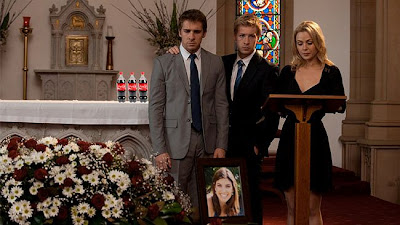
As viewers fast-forward, time-shift and download to avoid commercial breaks, product placement has been promoted as the solution for brands and marketers. Now, new technology allows brands to insert products and messages digitally, long after the TV show or movie has been shot. So is this virtual embedding the answer, or just another technical gimmick is search of a sucker?
A week or so back, Channel Seven announced a deal with MirriAd, a London-headquartered company with a proprietary tool that allows products or advertisements to be placed digitally into movies or TV shows after filming. Months, years or even decades after a scene has been shot, the MirriAd technology can drop in any product or message into any scene for any length of time.
Seven intends to use it on two of its top-rating shows, Home and Away and Packed to the Rafters.
The showreel on the MirriAd website shows Forrest Gump now sitting on a park bench painted with a Coke logo, The Cosby Show Huxtables trading banter around a breakfast table with a box of Special K in the centre, and Derek Zoolander unleashing Blue Steel to the backdrop of a poster for jeans.
The company claims this as the cure to time-shifting (and fast forwarding) television audience. And no doubt for many frustrated marketers and brands, it's an attractive sales pitch.
But will it work? Is it the future that its promoters claim it to be?
No. Not in and of itself.
Digital or otherwise, product placement isn't new. Jules Verne mentioned several companies as he serialised his novel Around The World In Eighty Days. Soap Operas got their tag because they were initially underwritten by companies like Unilever and Procter & Gamble. Mr Ed's Wilbur drove a Studebaker. The Bond film Tomorrow Never Dies famously turned $100 million before selling a ticket. Sometimes it worked.
But sometimes it didn't. Sylvester Stallone's 2001 feature Driven featured 103 brands in 117 minutes, but shifted few units of anything. Mostly due to the fact it was so awful, nobody sat through it.

Context is everything. MirriAd's technology is interesting, but technology won't shift a unit of product without an insight or idea that connects the brand back to the content they choose to watch.
In his book Buyology, Martin Lindstrom analysed the performance of three brands featured in the 2007 season of American Idol. Each of Ford, Cingulat (a wireless telephone network) and Coca-Cola had invested the same US$26 million, but each took a different approach to leveraging that investment.
Ford did little more than hire the contestants to appear in commercials that ran during the breaks. Cingular sponsored the ring-ins by which people voted performers on and off. While Coke took a far more integrated approach, putting cups of soft drink in front of the judges and having the cnotestants wait in a fire-engine red room, and siting on a sofa shaped in the style of the brand's signature bottle.
Lindstrom's findings were interesting. Amongst the focus groups, brand salience went backwards for Ford, improved a little for Cingular and went gangbusters for Coke. WIth a carefully crated and relevant strategy, the Atlanta kings were able to dominate the show and get great ROI (and, to Lindstrom's thinking, at the expense of their co-sponsors).
It seems obvious. Product placement where it is a relevant and believeable part of the story, can work. Because it ceases to become product placement and starts to become a part of the story. And it is here that creativity plays the crucial role.
When ET followed the Reece's Pieces into the boy's home, nobody in the audience saw the colour of Hershey's money. Because Spielberg understood that we all deal with brands every day, and created a believeable and charming moment.
If similar judgement is exercised with Packed To The Rafters, the positive results may ensue. But blind reliance on technology is a guarantee of nothing at all.